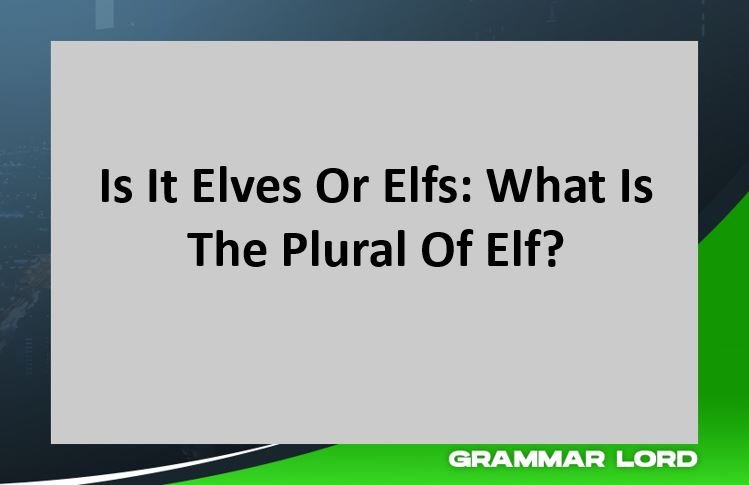The correct plural form of elf has been a subject of question for many. Let’s settle the debate once and for all.
Elves is the plural of elf.
Why Elves Is The Correct Plural?
The plural form of “elf” is “elves,” and not “elfs.” This follows a common rule in English grammar for forming the plural of nouns ending in “-f” or “-fe.”
For most nouns in English that end in “-f” or “-fe,” the plural is formed by simply adding “-s.” This creates a consistent and easily pronounced plural form. Here are some examples:
| Noun (Singular) | Noun (Plural) | Example Sentence |
|---|---|---|
| Knife | Knives | I need more knives for chopping vegetables. |
| Calf | Calves | The farmer watched over her newborn calves. |
| Wife | Wives | Many wives accompanied their husbands to war. |
| Leaf | Leaves | The strong winds blew the leaves off the trees. |
READ ALSO: What Is The Past Tense Of Spring
The noun “elf” follows this general rule. It ends in “-f,” so we simply add “-s” to form the plural “elves.” This aligns with the pronunciation and creates a grammatically correct plural form.
However, there are a few exceptions to this rule. Some nouns ending in “-f” or “-fe” form their plurals by changing the ending entirely. Here are some common examples:
| Noun (Singular) | Noun (Plural) | Example Sentence |
|---|---|---|
| Half | Halves | We need to cut the pizza into equal halves. |
| Roof | Roofs | The carpenters repaired the damaged roofs. |
| Wife | Wives (following the general rule) | Many wives accompanied their husbands to war. |
| Shelf | Shelves (following the general rule) | I organized the books on the shelves. |
READ ALSO: What Is The Past Tense Of Shut
As you can see, “elf” does not fall into one of these exceptional categories. It’s a standard noun following the general rule for forming plurals with “-f” endings.
The rule for adding “-s” to form plurals of nouns ending in “-f” or “-fe” has its roots in Old English. In Old English, most nouns with this ending formed their plurals by adding “-as.”
Over time, the “-as” ending gradually simplified to “-s” in Middle English, which is the form we use today. Also, some proper nouns ending in “-f” may retain their singular form for the plural (e.g., Cliff, Strauss).
And, some words borrowed from other languages could have irregular plural forms that don’t follow the “-s” rule (e.g., graffiti, alumni).
READ ALSO: What Is The Past Tense Of Drive?
How To Use “Elves” In A Sentence?
Let’s look at some ways to use the word “elves” in sentences:
Simple Sentences
- The elves made toys all night long.
- Little elves danced in the forest.
- We saw elves flying in the sky.
Longer Sentences
- Tiny, magical elves worked hard to get ready for Christmas.
- The elves, with their pointed ears and sparkly clothes, were fun to watch.
- If you’re lucky, you might see elves playing hide-and-seek in the woods.
Using “Elves” in Stories
- The elves played tricks on the sleeping humans.
- The old elf told stories by the fire.
- The elves’ laughter echoed through the forest.
Using “Elves” To Describe Things
- The room was full of elf-sized furniture.
- She had elf-like features, with big eyes and pointed ears.
- The cake was decorated with tiny elf dolls.
However, these are just a few examples.
FAQs
What Is The Plural Of Elf?
The plural of elf is elves.
Is It Correct To Say “Elfs”?
No, “elfs” is incorrect. The correct plural form is “elves.”
Why Is The Plural Of Elf “Elves” And Not “Elfs”?
This follows a general rule in English grammar for forming plurals of nouns ending in “-f” or “-fe.” Most of the time, we add “-s” to make them plural.
Are There Any Exceptions To The Rule For Pluralizing Words Ending In “f”?
Yes, there are a few exceptions. For example, the plural of “knife” is “knives,” and the plural of “calf” is “calves.” However, “elf” follows the general rule of adding “-s.”

